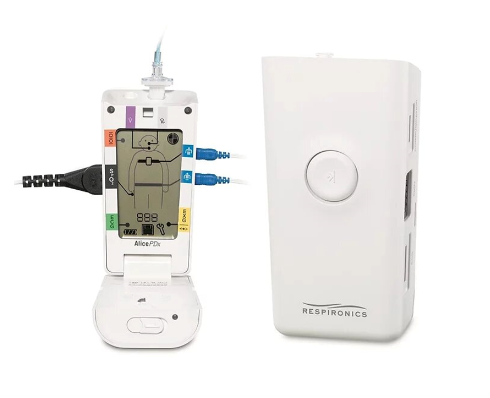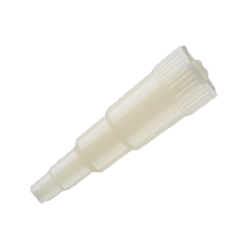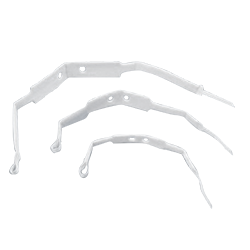Description
The Alice PDx Device is a portable sleep diagnostic system.
With its highly well-thought design, the Alice PDx is perfect for both home and hospital use.
Indication (for professionals)
The Alice PDx portable diagnostic recording device is your best ally if you suffer from sleep apnea. As it ensures screening, diagnostics, and follow-up in polysomnography and sleep disorder studies in general.
Features:
Excellent design
Sleep apnea is a condition that requires permanent surveillance. The Alice PDx is your gate towards a professional follow-up from the comfort of your own home, with an outstanding design, winner of the 2010 Medical Design Excellence Awards (MDEA) competition.
Simple data collection
The data collected in your sleep must be reviewed by your healthcare provider, for this, The Alice PDx came up with a very innovative feature allowing you an easy read of the data thanks to The Good Study Indicator that visually displays the amount of good quality data in 25% increments. This way, you can easily communicate with your doctor who then will decide if the study has to be repeated or not. Thus, saving you the time and effort of repeated visits to the clinic.
Computer data display
The Alice PDx can be directly connected to a computer using the Alice Sleepware software application where you can display both live and pre-recorded data.
Color-coded labels
We know how challenging it can be to connect the various sensors alone. The Alice PDx has made it simple for you. With color-coded labels on the perimeter of the device, an intuitive display, and a color-coded step-by-step diagram, sensor placement has never been easier!
Multi-night recording
The Alice PDx comes with an SD card and a 2-3 night battery life for an optimum experience whenever a multi-night recording is required. The recording can be set to start and stop automatically, making sure you have all the care you need even when you forget it.
How to use
1. Skin Preparation
Use alcohol wipes to clean:
- The center of your forehead
- The hair-line on the right side of your forehead
- 1 cm down and 1 cm out of your right eye
- Under the right portion of your chin
- The middle of your chin
- Behind your left ear
- Your right collar bone
- Your left collar bone
2. Equipment application
- Put the device lanyard around your neck and adjust it
- Adjust then attach the chest and waist bands
- Attach the belt connecter leads to the chest and waist bands
- Attach the electrodes to your skin:
o Green: Center forehead
o Red: forehead right hair-line
o Yellow: 1cm down and out your eye
o White: middle and right portion of the chin
o Black: behind your left ear
Make sure to put the hanging strings (green, red, yellow, and white) behind your right ear for more comfort.
- Attach the cannula
- Attach the oximeter to the index of your non-dominant hand
- Attach the tape securing the electrodes, the oximeter, and the cannula into place
You are all set now, try to sleep in your most comfortable position.
The report must then be read by your sleep physician to establish a diagnosis and treatment plan for you depending on your results.
Specifications:
1. Physical characteristics
| Size | 5 L x 3 W x 2 H (12.7 x 7.62 x 5.08) “/cm |
| Weight | Approximately 8 oz (230 grams), weight does not include batteries |
2. Input Signal Range
| ECG b | ± 4 mV |
| EEG d | ± 150 µV |
| EEG c | ± 500 µV |
3. Channels
| Total channels | Up to 21 with Optional EXG and ExG Yokes channels |
| Standard channels | Pressure Based (w/snore) and Thermal Airflow, zRIP Effort (2), Body Position, SpO2 (also Pleth and Pulse Rate), Respironics Therapy Device Parameters, Pressure and Flow from non-respironics therapy devices. channels |
| Optional Yokes/Channels (a) | ECG Yoke; 3-lead ECG providing 3 measured and 4 derived channels for a total of 7 channels |
| Optional Yokes/Channels | ExG Yoke: 4 Neuro Channels (EEG or EOG) and 3 Differential EMG, plus references and ground. |
4. Bandwidth
| ECG (a) | 0.318 to 81 Hz |
| EMG a | 9.7 to 86 Hz |
| EEG b | 0.318 to 35 Hz |
5. System Power Requirements
| Alkaline batteries | Three AA (1.5V) 0.43 watts typical |
6. Communication interfaces
| Serial Protocol | USB PC cable |
| SleepLink and Serial | Communication cables for our therapy devices |
7. Digital resolution
Up to 16bits
8. Input impedance
| ECG | 10 Mω per Electrode 20 Mω differential |
| EEG | 2 Mω per Electrode 4 Mω differential |
| EMG | 2 Mω per Electrode 4 Mω differential |
9. Max Storage Rate
| ECG/ExG | 200 Hz |
| Pressure Flow | 200 Hz |
| Body Pos. | 1 Hz |
| Effort and Thermal Flow | 100 Hz |
| Snore | 500 Hz |
10. Initial Sample Rate
Up to 1 Hz








Reviews
There are no reviews yet.